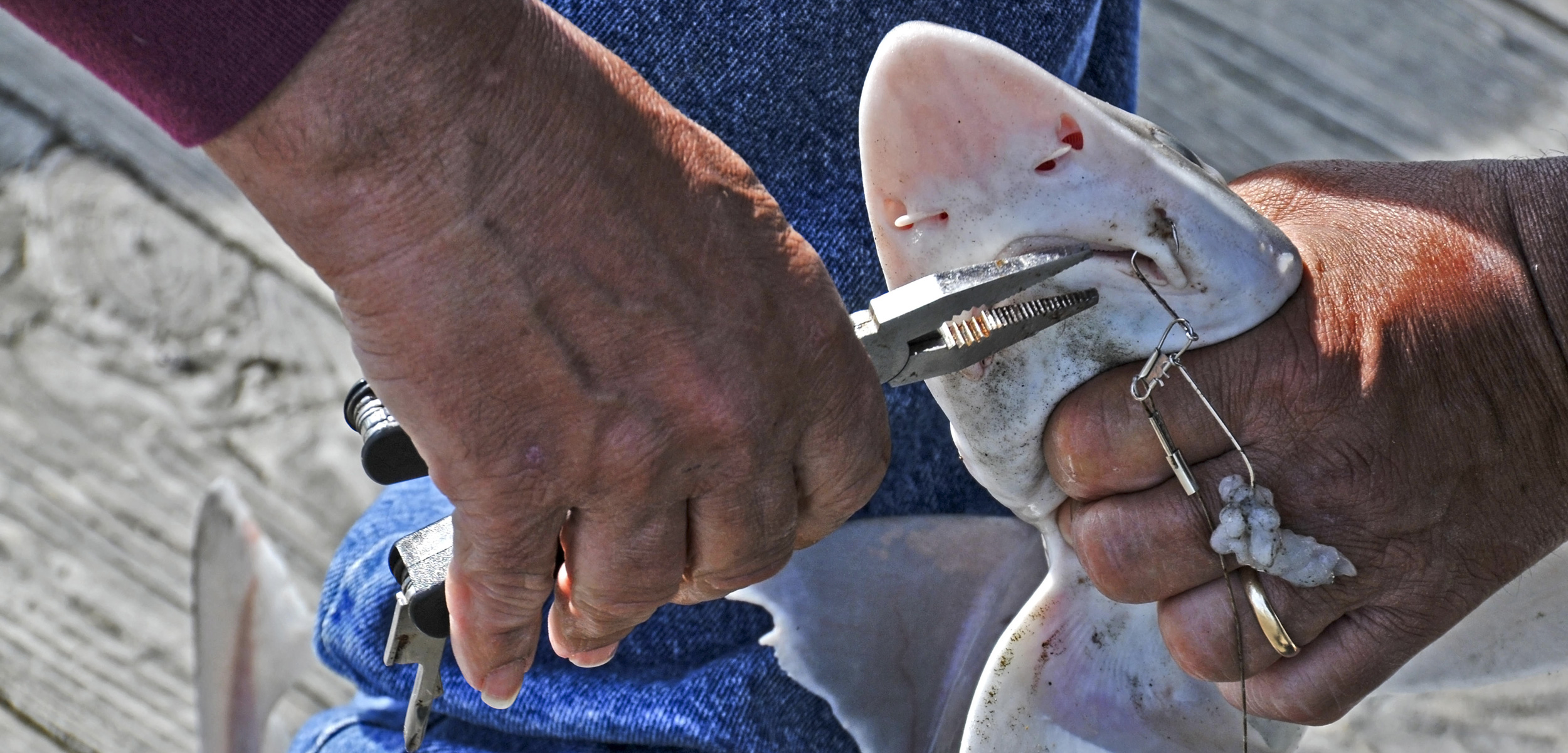For Sharks, Even Catch and Release Can Kill
Conservation-minded fishermen are doing more damage than they intend.
Article body copy
Within minutes of his fishing line going taut, Bill Nast knows what type of shark is on the other end. If the line runs out fast and far, it’s a blacktip or spinner; if it goes slower and stays closer, with the animal playing tug of war, it’s a bull shark. If it’s a hammerhead or tiger shark, he’ll see a dark gray silhouette in the water.
But what happens after—once the fight ends, the hook is removed, and the fish is returned to the water—is less certain.
Biologists are learning that some species of sharks can become so strained by the tussle of being caught that even if they are released, they’ll still die from the stress. This research echoes similar results seen in some freshwater fish species.
Nast, who runs fishing charters out of Yankeetown, Florida, has seen many sharks fight on a line for more than an hour. He’ll then pull the shark from the water, remove the hook, help his client snap a photo, and put the fish back. “I’ve never seen one die when I release it,” Nast says. “But he could swim a few hundred feet and then drop dead on the bottom, I don’t know.”
Austin Gallagher, a shark biologist with the University of Miami, has seen that. In 2014, his team attached a camera to a hook-caught great hammerhead and released it. After 10 minutes, they watched the shark list to one side, sink to the bottom, and die.
“It was an isolated case, and it was really unfortunate,” Gallagher says. “But it was certainly a big datapoint in understanding the thresholds of these animals. For hammerheads, it’s a very small threshold.”
Recent research has shown how the sensitivity of sharks to fishing stress varies by species. The most sensitive sharks to catch and release fishing include blacktips, popular among fishermen for their aggression and boundless energy, plus all species of threshers and hammerheads, which fishermen target for their unusual shape. These species consistently show signs of high stress in their blood chemistry post-capture, and are more likely to die on the boat or after release.
Data about the resilience of different species can also be gleaned from records of sharks captured as by-catch in commercial fisheries. Studies that analyze these records reveal a wide range of sensitivity, inferred from how many of each species died before they could be rereleased: as low as 6.8 percent of blue, 8.5 percent of tiger, and 15 percent of bull sharks, and as high as 88 percent of blacktip, 91 percent of Atlantic sharpnose, and 93 percent of great hammerhead sharks.
Killing sharks, however, is the opposite of what most recreational fishermen want. With hundreds of millions of sharks killed by commercial fisheries annually, many anglers have become advocates for keeping sharks alive. Numerous shark fishing tournaments are now catch and release, and according to the US National Oceanic and Atmospheric Administration, in 2014, the most recent year analyzed, US recreational fishermen reported releasing almost 98 percent of the sharks they caught.
“There seems to be an awareness among recreational anglers that something bad is going on, that shark populations are down, and that this is bad. But they also appear to believe that their own practices have no impact at all,” says David Shiffman*, also at the University of Miami. “That is just demonstratively not true.”
He says sport fishermen blame declining shark populations on commercial fishing. While commercial fisheries do indeed account for a large number of shark deaths, particularly outside of the United States, in recent years, recreational fishermen in the United States have caught more sharks than commercial fisheries.
Shiffman suggests fishermen who want to keep sharks alive should avoid targeting stress-sensitive species, and seek out more resilient animals such as tiger, blue, and lemon sharks. He also says fishermen should cut the line if a sensitive shark is accidentally hooked. For all species, he recommends limiting fight time, avoiding long periods of air exposure, and using circle hooks. In contrast to J-hooks, which sharks sometimes swallow, circle hooks embed more readily in the mouth, making them less dangerous to the shark and easier to remove.
Yet the idea that recreational shark fishermen hold any blame for shark deaths is contentious within that community. Shiffman and Gallagher say that in surveys and online fishing discussion boards, recreational fishermen are sometimes skeptical or even hostile to the concept that their activity hurts sharks. They are also leery of restrictions on where or what they can fish. Many fishermen say the science behind species-specific sensitivity is questionable.
Bo Johnson, a tournament shark angler and fishing charter guide in Pine Island, Florida, who has hosted shark researchers on his boat, says part of the problem with studying a fish to assess the effects of catch and release is that the process—taking sugar samples, blood counts, and attaching tags, for instance—subjects the fish to much more than it would experience during normal catch and release fishing. Gallagher contends that this is not the case for experienced researchers, who usually keep sharks submerged and limit interaction time.
Johnson only practices catch and release fishing, but he is firm that what he’s seen scientists do while testing sharks has not convinced him to change his methods.
Nast, meanwhile, is open to the scientists’ recommendations. “If I knew that to catch a fish and fight a fish would harm the fish, I personally wouldn’t be trying to catch that fish,” says Nast. “And if I did, I would try and take as much care of it as I could.”
*Editor’s note: David Shiffman has written about sharks and shark science for this magazine.

